Our Honored Guests
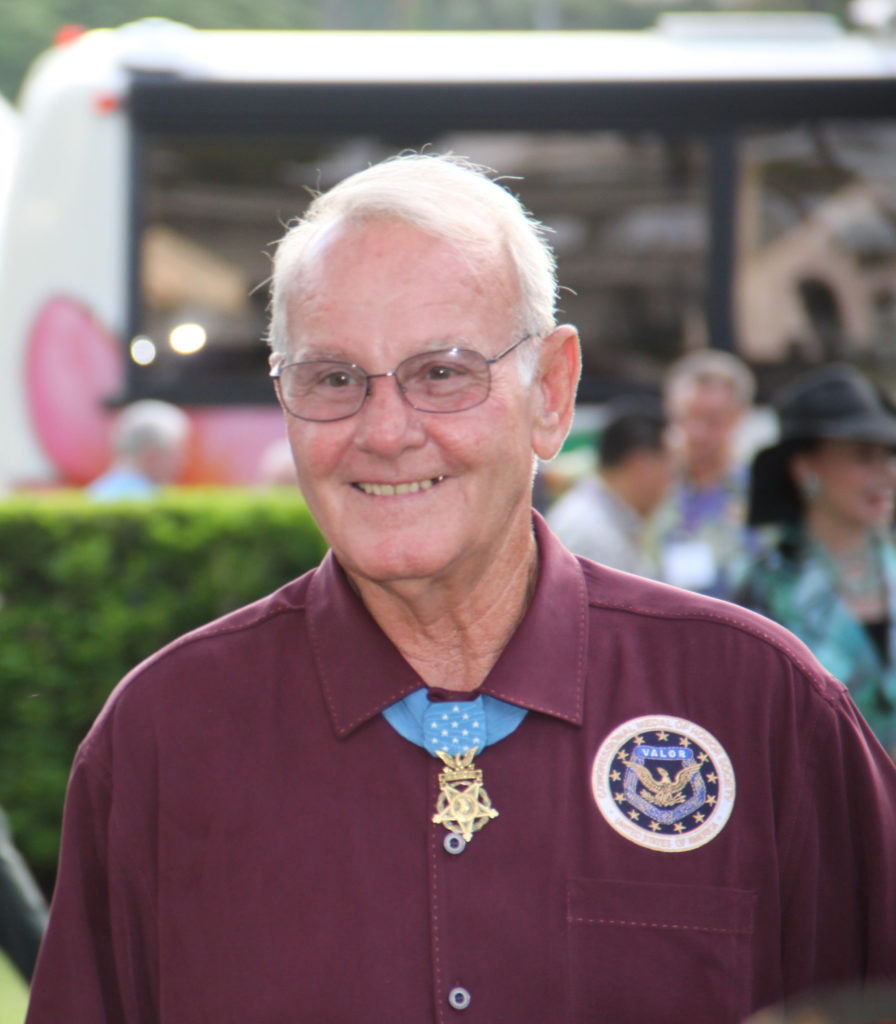
Vietnam War – U.S. Army
ROBERT MARTIN PATTERSON
DETAILS:
RANK: SPECIALIST FOURTH CLASS (RANK AT TIME OF PRESENTATION: SERGEANT; HIGHEST RANK: COMMAND SERGEANT MAJOR)
CONFLICT/ERA: VIETNAM WAR
UNIT/COMMAND:
3D PLATOON, TROOP B, 2D SQUADRON, 17TH CAVALRY,
101ST AIRBORNE DIVISION
MILITARY SERVICE BRANCH: U.S. ARMY
MEDAL OF HONOR ACTION DATE: MAY 6, 1968
MEDAL OF HONOR ACTION PLACE: NEAR LA CHU, REPUBLIC OF VIETNAM
CITATION
For conspicuous gallantry and intrepidity in action at the risk of his life above and beyond the call of duty. Sgt. Patterson (then Sp4c.) distinguished himself while serving as a fire team leader of the 3d Platoon, Troop B, during an assault against a North Vietnamese Army battalion which was entrenched in a heavily fortified position.
When the leading squad of the 3d Platoon was pinned down by heavy interlocking automatic-weapons and rocket-propelled-grenade fire from two enemy bunkers, Sgt. Patterson and the two other members of his assault team moved forward under a hail of enemy fire to destroy the bunkers with grenade and machine-gun fire.
Observing that his comrades were being fired on from a third enemy bunker covered by enemy gunners in one-man spider holes, Sgt. Patterson, with complete disregard for his safety and ignoring the warnings of his comrades that he was moving into a bunker complex, assaulted and destroyed the position.
Although exposed to intensive small-arms and grenade fire from the bunkers and their mutually supporting emplacements, Sgt. Patterson continued his assault upon the bunkers which were impeding the advance of his unit. Sgt. Patterson singlehandedly destroyed by rifle and grenade fire five enemy bunkers, killed eight enemy soldiers, and captured seven weapons.
His dauntless courage and heroism inspired his platoon to resume the attack and to penetrate the enemy defensive position. Sgt. Patterson’s action at the risk of his life has reflected great credit upon himself, his unit, and the U.S. Army.
Vietnam War – U.S. Army
MICHAEL JOHN FITZMAURICE
DETAILS
RANK: SPECIALIST FOURTH CLASS (HIGHEST RANK: TECHNICAL SERGEANT (AIR NATL GUARD))
CONFLICT/ERA: VIETNAM WAR
UNIT/COMMAND:
3D SQUAD, TROOP D, 2D SQUADRON, 17TH CAVALRY,
101ST AIRBORNE DIVISION (AIRMOBILE)
MILITARY SERVICE BRANCH: U.S. ARMY
MEDAL OF HONOR ACTION DATE: MARCH 23, 1971
MEDAL OF HONOR ACTION PLACE: KHESANH, REPUBLIC OF VIETNAM
CITATION
For conspicuous gallantry and intrepidity in action at the risk of his life above and beyond the call of duty. Sp4c. Fitzmaurice, 3d Platoon, Troop D, distinguished himself at Khesanh. Sp4c. Fitzmaurice and three fellow soldiers were occupying a bunker when a company of North Vietnamese sappers infiltrated the area. At the onset of the attack Sp4c. Fitzmaurice observed three explosive charges which had been thrown into the bunker by the enemy. Realizing the imminent danger to his comrades, and with complete disregard for his personal safety, he hurled two of the charges out of the bunker. He then threw his flak vest and himself over the remaining charge. By this courageous act he absorbed the blast and shielded his fellow soldiers. Although suffering from serious multiple wounds and partial loss of sight, he charged out of the bunker and engaged the enemy until his rifle was damaged by the blast of an enemy hand grenade. While in search of another weapon, Sp4c. Fitzmaurice encountered and overcame an enemy sapper in hand-to-hand combat. Having obtained another weapon, he returned to his original fighting position and inflicted additional casualties on the attacking enemy. Although seriously wounded, Sp4c. Fitzmaurice refused to be medically evacuated, preferring to remain at his post. Sp4c. Fitzmaurice’s extraordinary heroism in action at the risk of his life contributed significantly to the successful defense of the position and resulted in saving the lives of a number of his fellow soldiers. These acts of heroism go above and beyond the call of duty, are in keeping with the highest traditions of the military service, and reflect great credit on Sp4c. Fitzmaurice and the U.S. Army.
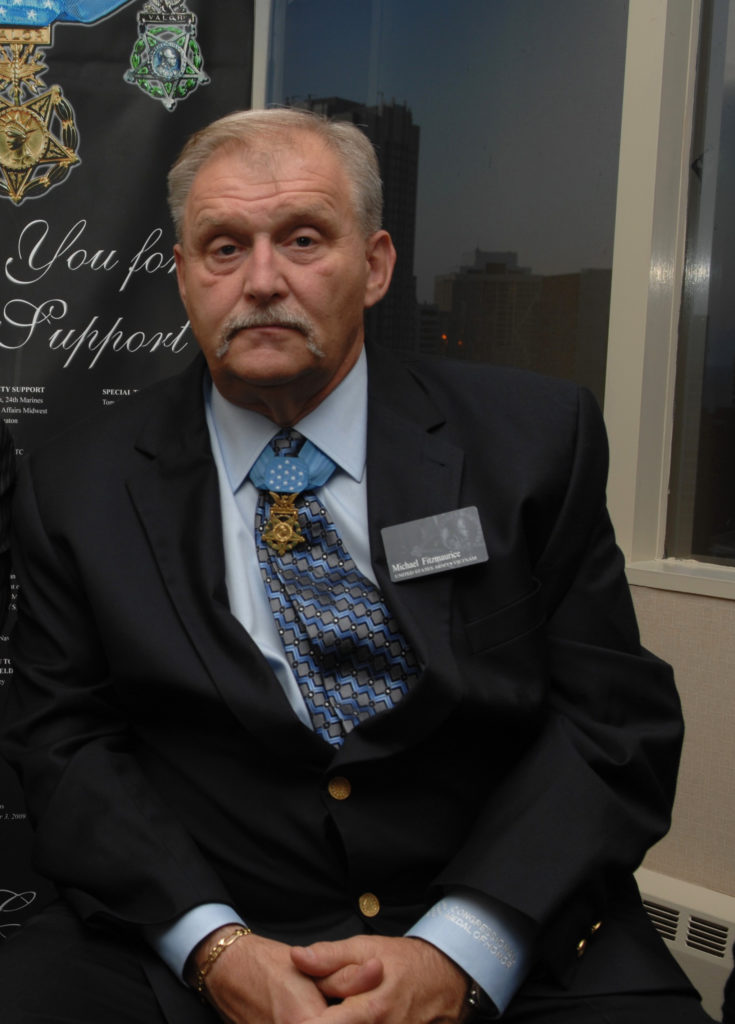
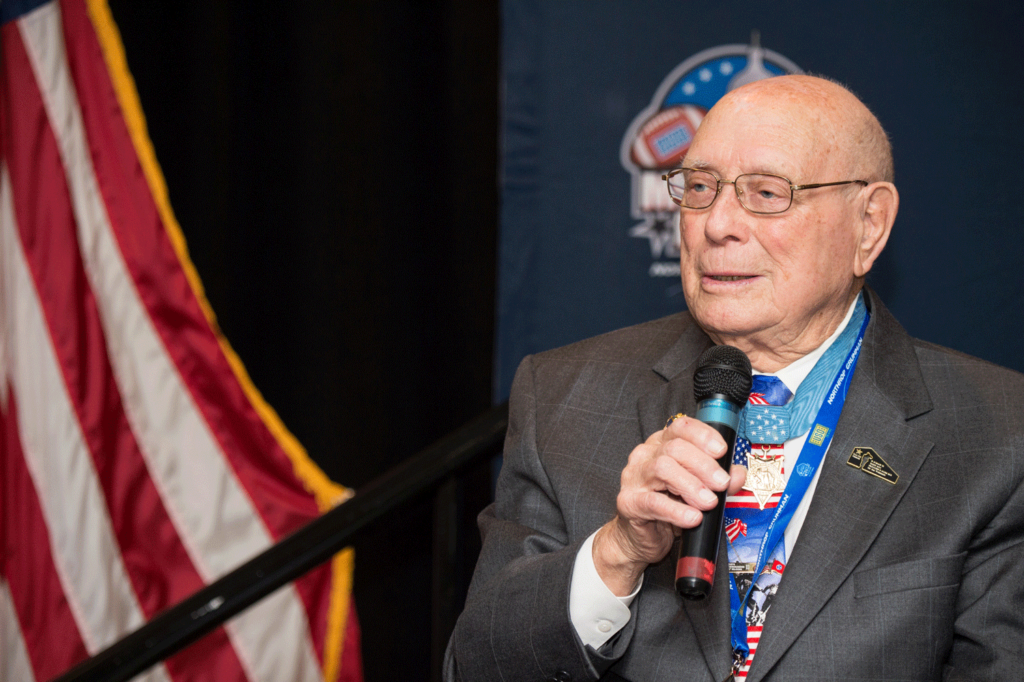
World War II – U.S. Marine Corps Reserve
HERSHEL WOODROW “WOODY” WILLIAMS
DETAILS
ALSO KNOWN AS: WILLIAMS, WOODY
RANK: CORPORAL (HIGHEST RANK: CHIEF WARRANT OFFICER FOUR)
CONFLICT/ERA: WORLD WAR II
UNIT/COMMAND:
HEADQUARTERS COMPANY, 1ST BATTALION, 21ST MARINES,
3D MARINE DIVISION
MILITARY SERVICE BRANCH: U.S. MARINE CORPS RESERVE
MEDAL OF HONOR ACTION DATE: FEBRUARY 23, 1945
MEDAL OF HONOR ACTION PLACE: IWO JIMA, VOLCANO ISLANDS
CITATION
For conspicuous gallantry and intrepidity at the risk of his life above and beyond the call of duty as demolition sergeant serving with the 21st Marines, 3d Marine Division, in action against enemy Japanese forces on Iwo Jima, Volcano Islands, 23 February 1945. Quick to volunteer his services when our tanks were maneuvering vainly to open a lane for the infantry through the network of reinforced concrete pillboxes, buried mines, and black volcanic sands, Cpl. Williams daringly went forward alone to attempt the reduction of devastating machine-gun fire from the unyielding positions. Covered only by four riflemen, he fought desperately for four hours under terrific enemy small-arms fire and repeatedly returned to his own lines to prepare demolition charges and obtain serviced flamethrowers, struggling back, frequently to the rear of hostile emplacements, to wipe out one position after another. On one occasion, he daringly mounted a pillbox to insert the nozzle of his flamethrower through the air vent, killing the occupants, and silencing the gun; on another he grimly charged enemy riflemen who attempted to stop him with bayonets and destroyed them with a burst of flame from his weapon. His unyielding determination and extraordinary heroism in the face of ruthless enemy resistance were directly instrumental in neutralizing one of the most fanatically defended Japanese strongpoints encountered by his regiment and aided vitally in enabling his company to reach its objective. Cpl. Williams’ aggressive fighting spirit and valiant devotion to duty throughout this fiercely contested action sustain and enhance the highest traditions of the U.S. Naval Service.
Vietnam War – U.S. Army
CLARENCE EUGENE SASSER
DETAILS
RANK: PRIVATE FIRST CLASS (RANK AT TIME OF PRESENTATION: SPECIALIST FIFTH CLASS; HIGHEST RANK: SPECIALIST FIFTH CLASS)
CONFLICT/ERA: VIETNAM WAR
UNIT/COMMAND:
HEADQUARTERS & HEADQUARTERS COMPANY, 3D BATTALION, 60TH INFANTRY,
9TH INFANTRY DIVISION
MILITARY SERVICE BRANCH: U.S. ARMY
MEDAL OF HONOR ACTION DATE: JANUARY 10, 1968
MEDAL OF HONOR ACTION PLACE: DING TUONG PROVINCE, REPUBLIC OF VIETNAM
CITATION
For conspicuous gallantry and intrepidity in action at the risk of his life above and beyond the call of duty. Sp5c. Sasser distinguished himself while assigned to Headquarters and Headquarters Company, 3d Battalion. He was serving as a medical aidman with Company A, 3d Battalion, on a reconnaissance-in-force operation. His company was making an air assault when suddenly it was taken under heavy small-arms, recoilless-rifle, machine-gun, and rocket fire from well-fortified enemy positions on three sides of the landing zone. During the first few minutes, over 30 casualties were sustained. Without hesitation, Sp5c. Sasser ran across an open rice paddy through a hail of fire to assist the wounded. After helping one man to safety, he was painfully wounded in the left shoulder by fragments of an exploding rocket. Refusing medical attention, he ran through a barrage of rocket and automatic-weapons fire to aid casualties of the initial attack and, after giving them urgently needed treatment, continued to search for other wounded. Despite two additional wounds immobilizing his legs, he dragged himself through the mud toward another soldier 100 meters away. Although in agonizing pain and faint from loss of blood, Sp5c. Sasser reached the man, treated him, and proceeded on to encourage another group of soldiers to crawl 200 meters to relative safety. There he attended their wounds for five hours until they were evacuated. Sp5c. Sasser’s extraordinary heroism is in keeping with the highest traditions of the military service and reflect great credit upon himself, his unit, and the U.S. Army.
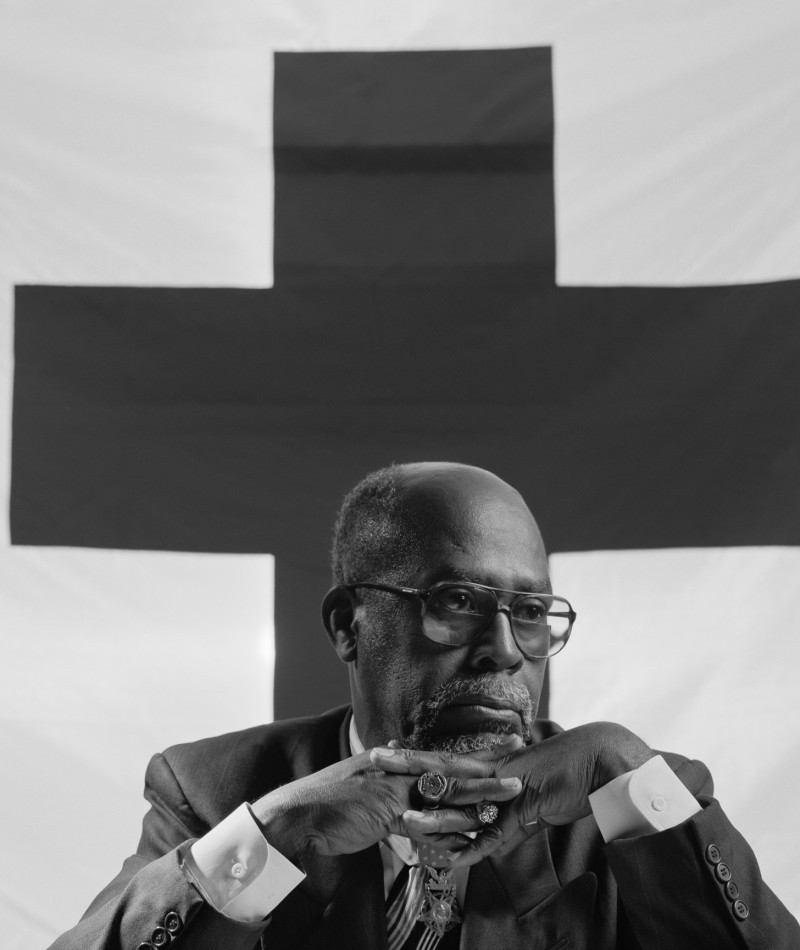
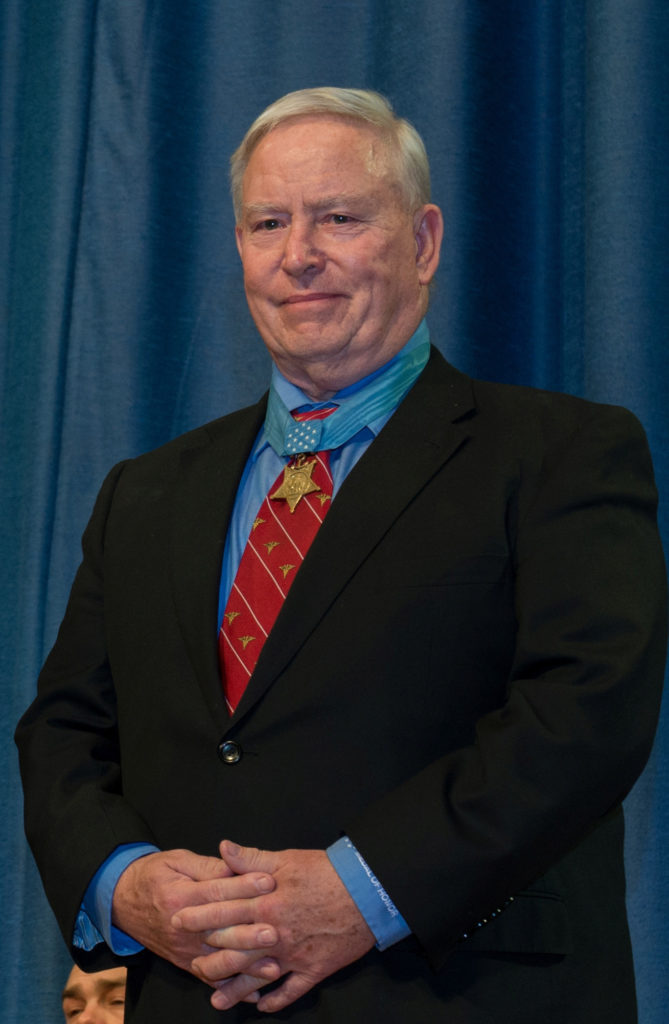
Vietnam War – U.S. Navy
DONALD EVERETT BALLARD
DETAILS
RANK: HOSPITAL CORPSMAN SECOND CLASS (HIGHEST RANK: COLONEL (ARNG))
CONFLICT/ERA: VIETNAM WAR
UNIT/COMMAND:
COMPANY M, 3D BATTALION, 4TH MARINES,
3D MARINE DIVISION
MILITARY SERVICE BRANCH: U.S. NAVY
MEDAL OF HONOR ACTION DATE: MAY 16, 1968
MEDAL OF HONOR ACTION PLACE: QUANG TRI PROVINCE, REPUBLIC OF VIETNAM
CITATION
For conspicuous gallantry and intrepidity at the risk of his life above and beyond the call of duty while serving as a HC2c. with Company M, in connection with operations against enemy aggressor forces. During the afternoon hours, Company M was moving to join the remainder of the 3d Battalion in Quang Tri province. After treating and evacuating two heat casualties, HC2c. Ballard was returning to his platoon from the evacuation landing zone when the company was ambushed by a North Vietnamese Army unit employing automatic weapons and mortars, and sustained numerous casualties. Observing a wounded marine, HC2c. Ballard unhesitatingly moved across the fire-swept terrain to the injured man and swiftly rendered medical assistance to his comrade. HC2c. Ballard then directed four marines to carry the casualty to a position of relative safety. As the four men prepared to move the wounded marine, an enemy soldier suddenly left his concealed position and, after hurling a hand grenade which landed near the casualty, commenced firing upon the small group of men. Instantly shouting a warning to the marines, HC2c. Ballard fearlessly threw himself upon the lethal explosive device to protect his comrades from the deadly blast. When the grenade failed to detonate, he calmly arose from his dangerous position and resolutely continued his determined efforts in treating other marine casualties. HC2c. Ballard’s heroic actions and selfless concern for the welfare of his companions served to inspire all who observed him and prevented possible injury or death to his fellow marines. His courage, daring initiative, and unwavering devotion to duty in the face of extreme personal danger, sustain and enhance the finest traditions of the U.S. Naval Service.
Vietnam War – U.S. Marine Corps
JAMES EVERETTE LIVINGSTON
DETAILS
RANK: CAPTAIN (HIGHEST RANK: MAJOR GENERAL)
CONFLICT/ERA: VIETNAM WAR
UNIT/COMMAND:
COMPANY E, 2D BATTALION, 4TH MARINES,
9TH MARINE AMPHIBIOUS BRIGADE
MILITARY SERVICE BRANCH: U.S. MARINE CORPS
MEDAL OF HONOR ACTION DATE: MAY 2, 1968
MEDAL OF HONOR ACTION PLACE: DAI DO, QUANG TRI PROVINCE, REPUBLIC OF VIETNAM
CITATION
For conspicuous gallantry and intrepidity at the risk of his life above and beyond the call of duty while serving as Commanding Officer, Company E, in action against enemy forces. Company E launched a determined assault on the heavily fortified village of Dai Do, which had been seized by the enemy on the preceding evening isolating a marine company from the remainder of the battalion. Skillfully employing screening agents, Capt. Livingston maneuvered his men to assault positions across 500 meters of dangerous open rice paddy while under intense enemy fire. Ignoring hostile rounds impacting near him, he fearlessly led his men in a savage assault against enemy emplacements within the village. While adjusting supporting arms fire, Capt. Livingston moved to the points of heaviest resistance, shouting words of encouragement to his marines, directing their fire, and spurring the dwindling momentum of the attack on repeated occasions. Although twice painfully wounded by grenade fragments, he refused medical treatment and courageously led his men in the destruction of over 100 mutually supporting bunkers, driving the remaining enemy from their positions and relieving the pressure on the stranded marine company. As the two companies consolidated positions and evacuated casualties, a third company passed through the friendly lines launching an assault on the adjacent village of Dinh To, only to be halted by a furious counterattack of an enemy battalion. Swiftly assessing the situation and disregarding the heavy volume of enemy fire, Capt. Livingston boldly maneuvered the remaining effective men of his company forward, joined forces with the heavily engaged marines, and halted the enemy’s counterattack. Wounded a third time and unable to walk, he steadfastly remained in the dangerously exposed area, deploying his men to more tenable positions and supervising the evacuation of casualties. Only when assured of the safety of his men did he allow himself to be evacuated. Capt. Livingston’s gallant actions uphold the highest traditions of the Marine Corps and the U.S. Naval Service.
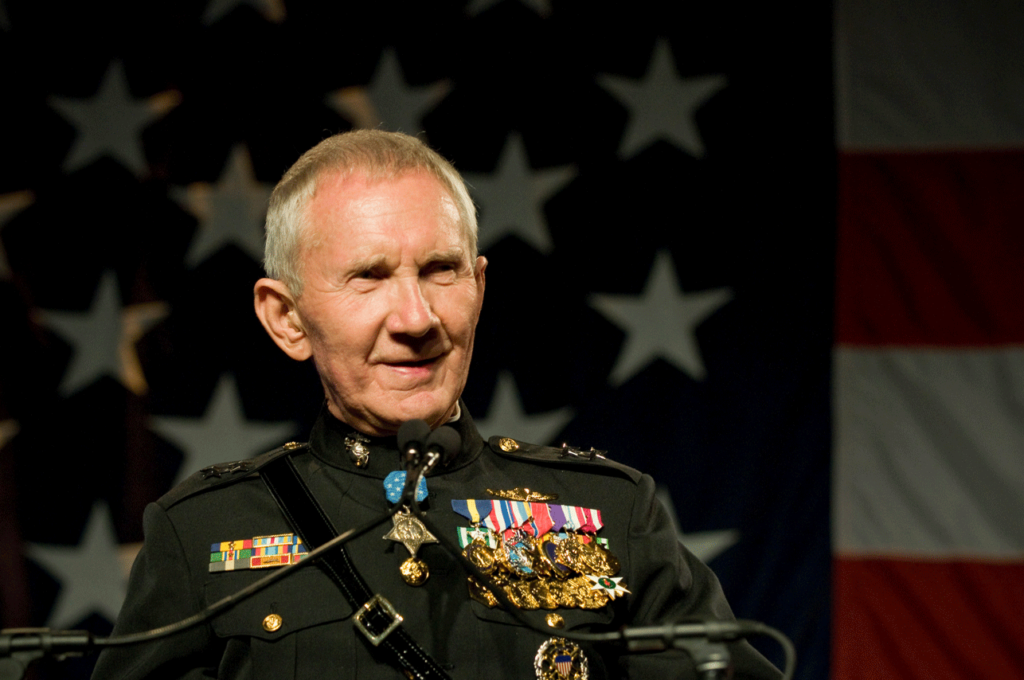
Download The Flyer
Click Here
Special Guests
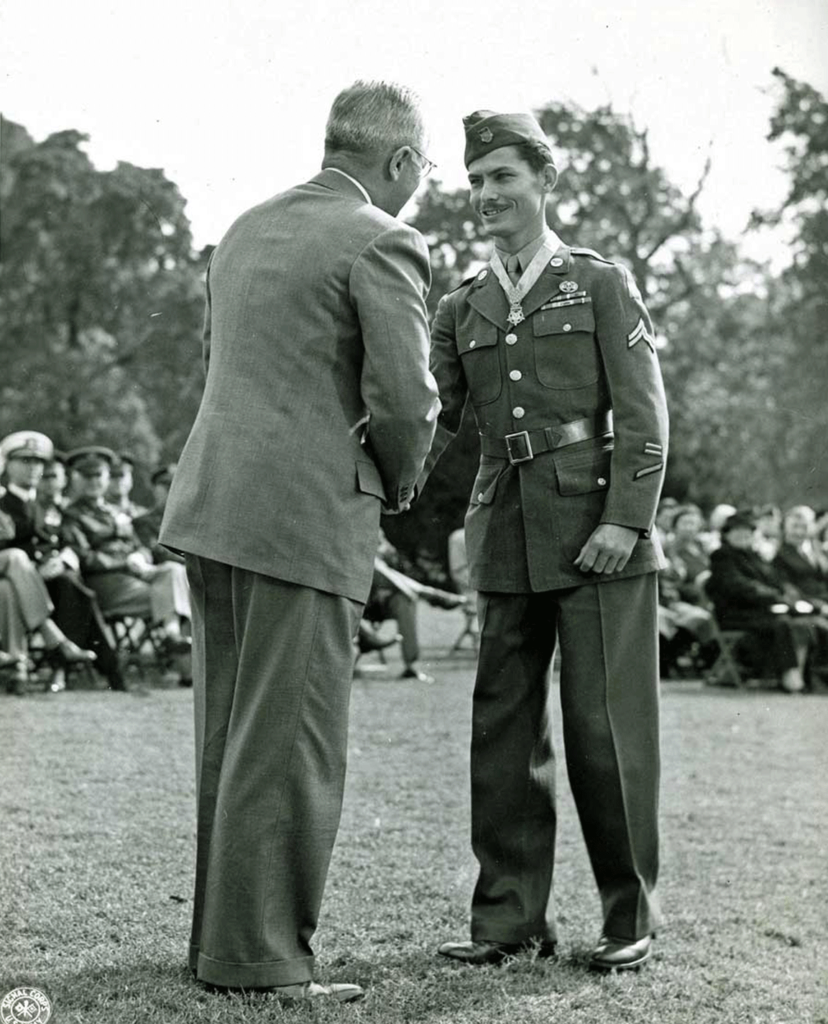
Desmond Doss Jr. son of,
World War II – U.S. Army
DESMOND THOMAS DOSS
DETAILS
RANK: PRIVATE FIRST CLASS (HIGHEST RANK: CORPORAL)
CONFLICT/ERA: WORLD WAR II
UNIT/COMMAND:
307TH INFANTRY, MEDICAL DETACHMENT,
77TH INFANTRY DIVISION
MILITARY SERVICE BRANCH: U.S. ARMY
MEDAL OF HONOR ACTION DATE: APRIL 29 – MAY 21, 1945
MEDAL OF HONOR ACTION PLACE: URASOE-MURA, OKINAWA, RYUKYU ISLANDS
CITATION
He was a company aidman when the 1st Battalion assaulted a jagged escarpment 400 feet high. As our troops gained the summit, a heavy concentration of artillery, mortar, and machine-gun fire crashed into them, inflicting approximately 75 casualties and driving the others back. Pfc. Doss refused to seek cover and remained in the fire-swept area with the many stricken, carrying them one by one to the edge of the escarpment and there lowering them on a rope-supported litter down the face of a cliff to friendly hands. On 2 May, he exposed himself to heavy rifle and mortar fire in rescuing a wounded man 200 yards forward of the lines on the same escarpment; and two days later he treated four men who had been cut down while assaulting a strongly defended cave, advancing through a shower of grenades to within eight yards of enemy forces in a cave’s mouth, where he dressed his comrades’ wounds before making four separate trips under fire to evacuate them to safety. On 5 May, he unhesitatingly braved enemy shelling and small-arms fire to assist an artillery officer. He applied bandages, moved his patient to a spot that offered protection from small-arms fire, and, while artillery and mortar shells fell close by, painstakingly administered plasma. Later that day, when an American was severely wounded by fire from a cave, Pfc. Doss crawled to him where he had fallen 25 feet from the enemy position, rendered aid, and carried him 100 yards to safety while continually exposed to enemy fire. On 21 May, in a night attack on high ground near Shuri, he remained in exposed territory while the rest of his company took cover, fearlessly risking the chance that he would be mistaken for an infiltrating Japanese and giving aid to the injured until he was himself seriously wounded in the legs by the explosion of a grenade. Rather than call another aidman from cover, he cared for his own injuries and waited five hours before litter bearers reached him and started carrying him to cover. The trio was caught in an enemy tank attack and Pfc. Doss, seeing a more critically wounded man nearby, crawled off the litter and directed the bearers to give their first attention to the other man. Awaiting the litter bearers’ return, he was again struck, this time suffering a compound fracture of one arm. With magnificent fortitude he bound a rifle stock to his shattered arm as a splint and then crawled 300 yards over rough terrain to the aid station. Through his outstanding bravery and unflinching determination in the face of desperately dangerous conditions Pfc. Doss saved the lives of many soldiers. His name became a symbol throughout the 77th Infantry Division for outstanding gallantry far above and beyond the call of duty.
Kirk Davis, son of:
World War II – U.S. Army
CHARLES WILLIS DAVIS
DETAILS
RANK: MAJOR (RANK AT TIME OF ACTION: CAPTAIN)
CONFLICT/ERA: WORLD WAR II
UNIT/COMMAND:
2D BATTALION, 27TH INFANTRY REGIMENT,
25TH INFANTRY DIVISION
MILITARY SERVICE BRANCH: U.S. ARMY
MEDAL OF HONOR ACTION DATE: JANUARY 12, 1943
MEDAL OF HONOR ACTION PLACE: GUADALCANAL, SOLOMON ISLANDS
CITATION
For distinguishing himself conspicuously by gallantry and intrepidity at the risk of his life above and beyond the call of duty in action with the enemy on Guadalcanal Island. On 12 January 1943, Maj. Davis (then Capt.), executive officer of an infantry battalion, volunteered to carry instructions to the leading companies of his battalion which had been caught in crossfire from Japanese machine guns. With complete disregard for his own safety, he made his way to the trapped units, delivered the instructions, supervised their execution, and remained overnight in this exposed position. On the following day, Maj. Davis again volunteered to lead an assault on the Japanese position which was holding up the advance. When his rifle jammed at its first shot, he drew his pistol and, waving his men on, led the assault over the top of the hill. Electrified by this action, another body of soldiers followed and seized the hill. The capture of this position broke Japanese resistance and the battalion was then able to proceed and secure the corps’ objective. The courage and leadership displayed by Maj. Davis inspired the entire battalion and unquestionably led to the success of its attack.
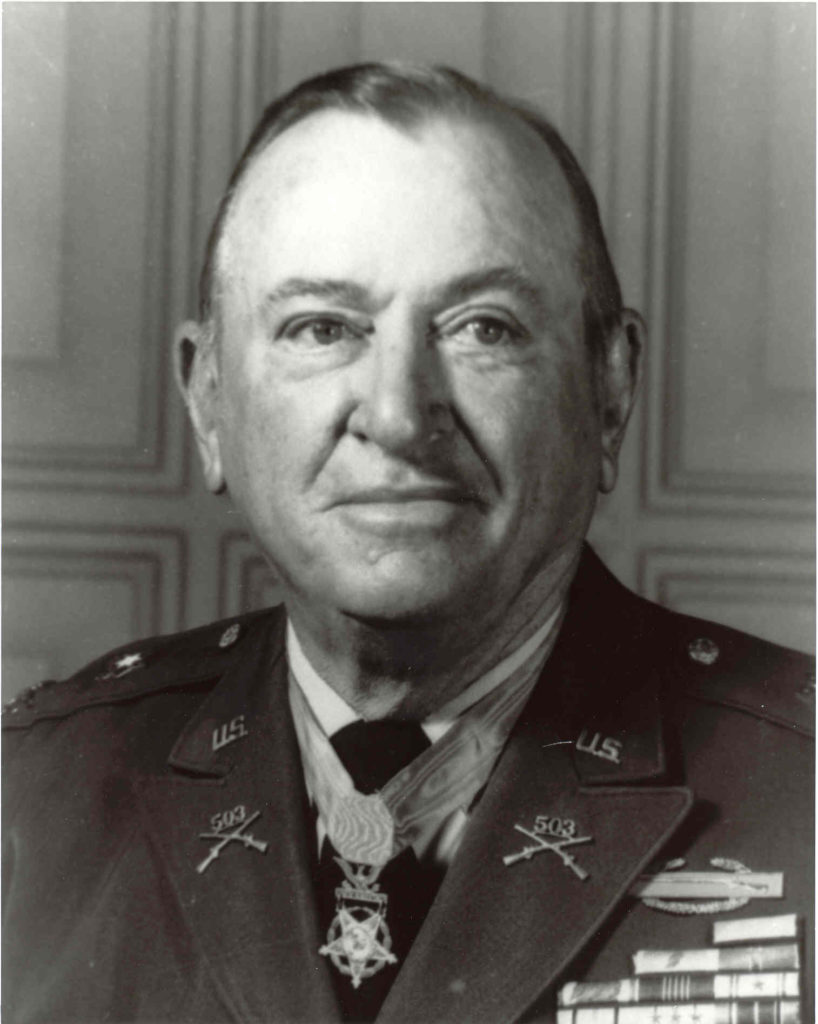
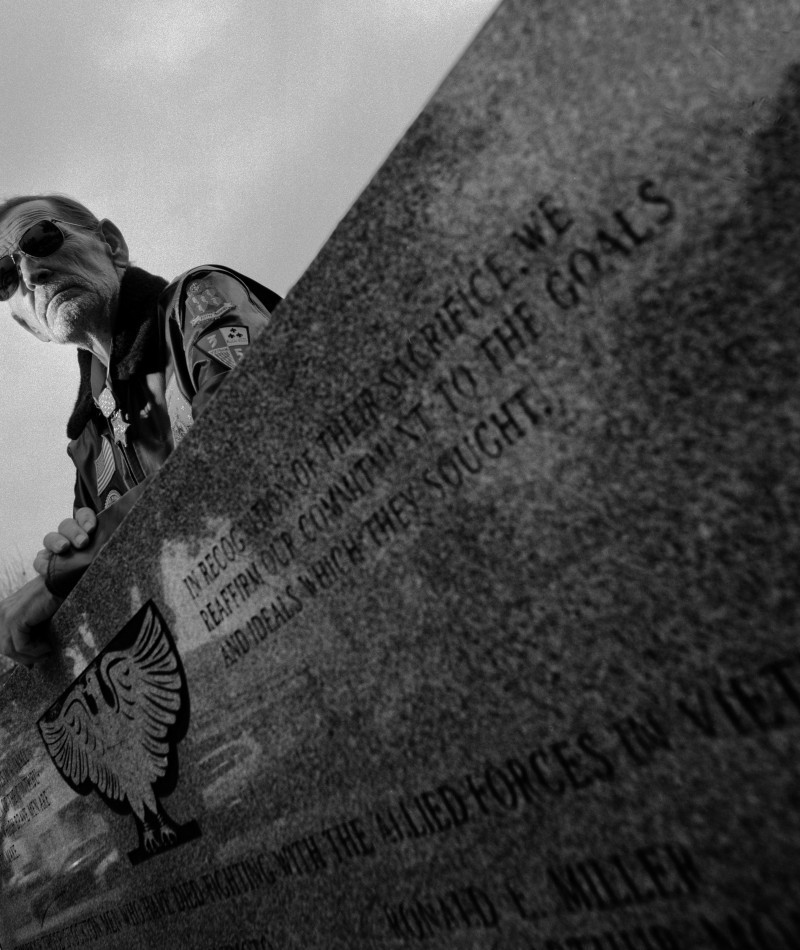
Patty Pittman – Widow
Vietnam War – U.S. Marine Corps
RICHARD ALLAN PITTMAN
DETAILS
RANK: SERGEANT (RANK AT TIME OF ACTION: LANCE CORPORAL)
CONFLICT/ERA: VIETNAM WAR
UNIT/COMMAND:
COMPANY I, 3D BATTALION, 5TH MARINES,
1ST MARINE DIVISION (REIN) FMF
MILITARY SERVICE BRANCH: U.S. MARINE CORPS
MEDAL OF HONOR ACTION DATE: JULY 24, 1966
MEDAL OF HONOR ACTION PLACE: NEAR THE DEMILITARIZED ZONE, REPUBLIC OF VIETNAM
CITATION
For conspicuous gallantry and intrepidity at the risk of his life above and beyond the call of duty. While Company I was conducting an operation along the axis of a narrow jungle trail, the leading company elements suffered numerous casualties when they suddenly came under heavy fire from a well-concealed and numerically superior force. Hearing the engaged marines’ calls for more firepower, Sgt. Pittman quickly exchanged his rifle for a machine gun and several belts of ammunition, left the relative safety of his platoon, and unhesitatingly rushed forward to aid his comrades. Taken under intense enemy small-arms fire at point-blank range during his advance, he returned the fire, silencing the enemy position. As Sgt. Pittman continued to forge forward to aid members of the leading platoon, he again came under heavy fire from two automatic weapons which he promptly destroyed. Learning that there were additional wounded marines 50 yards further along the trail, he braved a withering hail of enemy mortar and small-arms fire to continue onward. As he reached the position where the leading marines had fallen, he was suddenly confronted with a bold frontal attack by 30 to 40 enemy. Totally disregarding his safety, he calmly established a position in the middle of the trail and raked the advancing enemy with devastating machine-gun fire. His weapon rendered ineffective, he picked up an enemy submachine gun and, together with a pistol seized from a fallen comrade, continued his lethal fire until the enemy force had withdrawn. Having exhausted his ammunition except for a grenade which he hurled at the enemy, he then rejoined his platoon. Sgt. Pittman’s daring initiative, bold fighting spirit, and selfless devotion to duty inflicted many enemy casualties, disrupted the enemy attack, and saved the lives of many of his wounded comrades. His personal valor at grave risk to himself reflects the highest credit upon himself, the Marine Corps, and the U.S. Naval Service.